Predicting Fire
Can I predict a fire’s behavior?
Fire behaves in predictable ways, and how it will act can be anticipated both before and during a prescribed burn based on certain criteria.
Conditions influencing fire behavior

First, fire behavior is influenced by conditions of the material being burned—the fuel. Things to assess include: Is the fuel type light, such as grass, or heavy, such as downed logs? How much moisture is the material holding? What’s the quantity of fuel?
A pile of dead logs, for example, can create an intense fire during a prescribed burn that will likely damage nearby trees.
Temperature, relative humidity, and wind also greatly affect fire behavior. Fire burns hotter and faster with increased temperature. Relative humidity (RH) is the amount of moisture in the air relative to the total amount of moisture the air can hold. At a low RH, fuels get very dry, making them easier to ignite.
Wind direction and speed are critically important to knowing where the fire will go and how fast it will spread. The shape of the land (topography) and direction a slope faces (aspect) are also key. Fire moves uphill rapidly and downhill slowly.
Moreover, if the slope of the hill faces south, fuels are likely to be drier from exposure to the sun and prevailing south and west winds, making them burn hotter and faster.
The best conditions for a burn
Using all of these factors, fire managers decide how to conduct the burn and identify the most desirable weather conditions for a given burn unit. Managers usually aim to conduct a burn when temperatures, RH, and wind speeds are moderate.
Because wind affects fire so strongly, you might think it would be best to burn under very light or calm winds. But that’s not true, and here’s why. In a prescribed burn, consistent wind speed and direction make the fire predictable to an experienced manager.
If winds are calm or light, and variable in direction, the fire’s movement is harder to control – risking your safety, personal property, and forest resources.
